| This article's lead section may be too short to adequately summarize the key points. Please consider expanding the lead to provide an accessible overview of all important aspects of the article. (February 2022) |
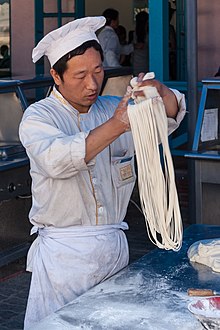 Traditional noodle-making involving hand-pulling in Dalian, Liaoning, China Traditional noodle-making involving hand-pulling in Dalian, Liaoning, China | |
| Place of origin | The earliest record of noodles was discovered in northwestern China, from 4,000 years ago. |
|---|---|
| Main ingredients | Unleavened dough |
Noodles are a type of food made from unleavened dough which is either rolled flat and cut, stretched, or extruded, into long strips or strings. Noodles are a staple food in many cultures and made into a variety of shapes. The most common noodles are those derived from either Chinese cuisine or Italian cuisine. Chinese noodles are known by a variety of different names, while Italian noodles are known as pasta.
While long, thin strips may be the most common, many varieties of noodles are cut into waves, helices, tubes, strings, or shells, or folded over, or cut into other shapes. Noodles are usually cooked in boiling water, sometimes with cooking oil or salt added. They can also be steamed, pan-fried, deep-fried, or baked. Noodles are often served with an accompanying sauce or in a soup, the latter being known as noodle soup. Noodles can be refrigerated for short-term storage or dried and stored for future use.
Etymology
The word for noodles in English was borrowed in the 18th century from the German word Nudel (German: [ˈnuːdl̩] ). The German word likely came from Knodel or Nutel, and referred to any dumpling, though mostly of wheat.
Colloquial uses for noodle to refer to someone's head, or to a "dummy" are unrelated, and likely came from the older English word noddle.
History
Origin
The earliest written record of noodles is found in a book dated to the Eastern Han period (25–220 CE). Noodles made from wheat dough became a prominent food for the people of the Han dynasty. The oldest evidence of noodles was from 4,000 years ago in China. In 2005, a team of archaeologists reported finding an earthenware bowl that contained 4,000-year-old noodles at the Lajia archaeological site. These noodles were said to resemble lamian, a type of Chinese noodle. Analyzing the husk phytoliths and starch grains present in the sediment associated with the noodles, they were identified as millet belonging to Panicum miliaceum and Setaria italica. However, other researchers cast doubt that Lajia's noodles were made from specifically millet: it is difficult to make pure millet noodles, it is unclear whether the analyzed residue were directly derived from Lajia's noodles themselves, starch morphology after cooking shows distinctive alterations that does not fit with Lajia's noodles, and it is uncertain whether the starch-like grains from Laijia's noodles are starch as they show some non-starch characteristics.
Food historians generally estimate that pasta's origin is from among the Mediterranean countries: a homogenous mixture of flour and water called itrion as described by 2nd-century Greek physician Galen, among 3rd to 5th-century Jews as itrium as described by the Jerusalem Talmud and as itriyya (Arabic cognate of the Greek word), string-like shapes made of semolina and dried before cooking as defined by the 9th-century physician and lexicographer Isho bar Ali.
Historical variations
East Asia
See also: Chinese noodles
There are over 1,200 types of noodles commonly consumed in China today. They vary widely according to the region of production, ingredients, shape or width, and manner of preparation. Due to the vast diversity of Chinese noodles, there is no single Chinese word equivalent to the Western concept of "noodles," nor is the notion of "noodles" as a unified food category recognized within Chinese cuisine.
In Standard Mandarin, miàn (simplified Chinese: 面; traditional Chinese: 麵) means "dough" but can be used to refer to noodles made from wheat flour and grains such as millet, sorghum, and oats. While fěn (粉) means "powder" but can be used to refer to noodles made from other starches, particularly rice flour and mung bean starch.
Wheat noodles in Japan (udon) were adapted from a Chinese recipe as early as the 9th century. Innovations continued, such as noodles made with buckwheat (naengmyeon) were developed in the Joseon Dynasty of Korea (1392–1897). Ramen noodles, based on southern Chinese noodle dishes from Guangzhou but named after the northern Chinese lamian, became common in Japan by 1900.
Central Asia
Kesme or erişte noodles were eaten by Turkic peoples by the 13th century.
West Asia
Ash reshteh (noodles in thick soup with herbs) is one of the most popular dishes in some middle eastern countries such as Iran.
Europe

In the 1st century BCE, Horace wrote of fried sheets of dough called lagana. However, the cooking method does not correspond to the current definition of either a fresh or dry pasta product.
Italy
The first concrete information on pasta products in Italy dates back to the Etruscan civilization, the Testaroli. The first noodles will only appear much later, in the 10th or 11th centuries, and there is a popular legend about Marco Polo bringing the first pasta back from China. Modern historians do not give much credibility to the story and rather believe the first noodles were imported earlier from the Arabs, in a form called rishta. Pasta has taken on a variety of shapes, often based on regional specializations.
Germany
In Germany, documents dating from 1725 mention Spätzle. Medieval illustrations are believed to place this noodle at an even earlier date.
Armenia
Armenian variety of noodle, Arishta, is prepared from wheat, water and salt. It is thick and is usually eaten with matzoon, clarified butter and garlic.
Ancient Israel and diaspora
The Latinized word itrium referred to a kind of boiled dough. Arabs adapted noodles for long journeys in the fifth century, the first written record of dry pasta. Muhammad al-Idrisi wrote in 1154 that itriyya was manufactured and exported from Norman Sicily. Itriya was also known by the Persian Jews during early Persian rule (when they spoke Aramaic) and during Islamic rule. It referred to a small soup noodle, of Greek origin, prepared by twisting bits of kneaded dough into shape, resembling Italian orzo.
Polish Jews
Zacierki is a type of noodle found in Polish Jewish cuisine. It was part of the rations distributed to Jewish victims in the Łódź Ghetto by the Nazis. (Out of the "major ghettos", Łódź was the most affected by hunger, starvation and malnutrition-related deaths.) The diary of a young Jewish girl from Łódź recounts a fight she had with her father over a spoonful of zacierki taken from the family's meager supply of 200 grams a week.
Types by primary ingredient
See also: List of noodles
Wheat
RiceMain article: Rice noodles
|
Buckwheat
EggEgg noodles are made of a mixture of egg and flour.
Others
|
-
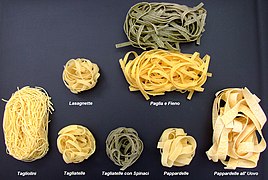 Egg pasta
Egg pasta
-
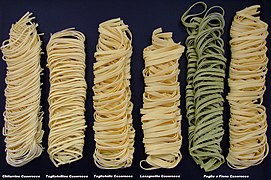 Fresh pasta
Fresh pasta
-
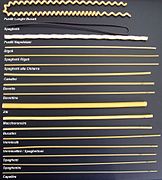 Long pasta
Long pasta
-
 Idiyappam, Indian rice noodles
Idiyappam, Indian rice noodles
-
 Mixian (米线) rice noodles being cooked in copper pots (铜锅), China
Mixian (米线) rice noodles being cooked in copper pots (铜锅), China
-
Wide, uncooked egg noodles
-
 Some different types of noodles commonly found in Southeast Asia
Some different types of noodles commonly found in Southeast Asia
Types of dishes
See also: List of noodle dishes
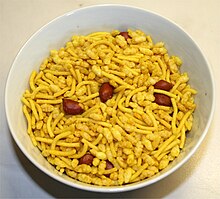
- Baked noodles: Boiled and drained noodles are combined with other ingredients and baked. Common examples include many casseroles.
- Basic noodles: These are cooked in water or broth, then drained. Other foods can be added or the noodles are added to other foods (see fried noodles) or the noodles can be served plain with a dipping sauce or oil to be added at the table. In general, noodles are soft and absorb flavors.
- Chilled noodles: noodles that are served cold, sometimes in a salad. Examples include Thai glass noodle salad and cold udon.
- Fried noodles: dishes made of noodles stir fried with various meats, seafood, vegetables, and dairy products. Examples include chow mein, lo mein, mie goreng, hokkien mee, some varieties of pancit, yakisoba, tallarín saltado, and pad thai.
- Noodle soup: noodles served in broth. Examples include phở, beef noodle soup, chicken noodle soup, ramen, laksa, mie ayam, saimin, and batchoy.
Preservation
See also
- Chinese noodles
- Filipino pancit
- Italian pasta
- Japanese noodles
- Korean noodles
- Vietnamese noodles
- Cold noodles
- List of noodle restaurants
References
- ^ Roach, John (12 October 2005). "4,000-Year-Old Noodles Found in China". National Geographic: 1–2. Archived from the original on 20 October 2005.
- "noodle | Definition of noodle in English by Oxford Dictionaries". Oxford Dictionaries | English. Archived from the original on 31 March 2019. Retrieved 7 May 2019.
- ^ Dean, Sam (18 January 2013). "The Origin of the Word Noodle". Bon Appétit. Retrieved 12 October 2023.
- Sinclair & Sinclair 2010, p. 91.
- ^ Lu, Houyuan; Yang, Xiaoyan; Ye, Maolin; et al. (13 October 2005). "Culinary archaeology: Millet noodles in Late Neolithic China". Nature. 437 (7061): 967–968. Bibcode:2005Natur.437..967L. doi:10.1038/437967a. PMID 16222289. S2CID 4385122.
- Ge, W.; Liu, L.; Chen, X.; Jin, Z. (2011). "Can noodles be made from millet? An experimental investigation of noodle manufacture together with starch grain analyses". Archaeometry. 53: 194–204. doi:10.1111/j.1475-4754.2010.00539.x.
- López, Alfonso (8 July 2016). "The Twisted History of Pasta". National Geographic. Archived from the original on 14 December 2019. Retrieved 13 December 2019.
- ^ Serventi & Sabban 2002, p. 17.
- Serventi & Sabban 2002, p. 29.
- "A medical text in Arabic written by a Jewish doctor living in Tunisia in the early 900s" (Dickie 2008: 21).
- "Noodles in Contemporary China: Social Aspects underlying the Noodle Evolution (Qiulun Li) – Noodles on the Silk Road". Retrieved 1 July 2022.
- RAICHLEN, STEVEN (30 January 1992). "Noodle nomenclature". Atlanta Journal-Constitution, The (GA). pp. W/6.
- "Japanese Noodles (No. 4)". Kikkoman Corporation (in Japanese). Retrieved 20 July 2022.
- "Part 1: China Origin". Ramen Culture. Retrieved 20 July 2022.
- Media, USEN. "Indespensable Knowledge For Every Ramen Lover! A Glossary with Shop Recommendations". SAVOR JAPAN. Retrieved 20 July 2022.
- "榨菜肉丝面的南北差异及制作方法". Sohu.
- Serventi & Sabban 2002, pp. 15–16 & 24.
- Serventi & Sabban 2002, pp. 15–16.
- Serventi & Sabban 2002, p. 10.
- Toscana, Cucina (12 July 2017). "The International Origins of Pasta | Cucina Toscana Salt Lake City". Cucina Toscana. Retrieved 18 May 2023.
- "City Profile: Stuttgart". London: Embassy of Germany, London. Archived from the original (PDF) on 27 July 2017. Retrieved 26 November 2015.
Spätzle is a city specialty.
- Phoenix (5 November 2022). "Arishta - Traditional Armenian Homestyle Pasta". Phoenix Tour Armenia. Retrieved 13 November 2024.
- Rodinson, Perry & Arberry 2001, p. 253.
- Strybel, Robert; Strybel, Maria (2005). Polish Heritage Cookery. Hippocrene Books. ISBN 978-0-7818-1124-8.
- Zapruder, Alexandra (2015). Salvaged Pages: Young Writers' Diaries of the Holocaust. Yale University Press. pp. 226–242. ISBN 978-0-300-20599-2.
- Heberer, Patricia (31 May 2011). Children during the Holocaust. Rowman Altamira. ISBN 978-0-7591-1986-4.
- Kitchen, Leanne (8 January 2019). "Know your noodle: The ultimate guide to Asian noodles". SBS-TV. Retrieved 24 March 2020.
- Klatskin, Debbie. "Lokshen Noodles". PBS. Retrieved 24 March 2020.
- "Turkish Egg Noodle (Erişte)". Almost Turkish Recipes. Retrieved 24 March 2020.
- Cloake, Felicity (20 February 2019). "How to make perfect spätzle noodles". The Guardian. Retrieved 24 March 2020.
Bibliography
- Dickie, John (1 October 2010). Delizia! The Epic History of Italians and Their Food (Paper). New York: Atria Books. ISBN 0743278070.
- Errington, Frederick et al. eds. The Noodle Narratives: The Global Rise of an Industrial Food into the Twenty-First Century (U. of California Press; 2013) 216 pages; studies three markets for instant noodles: Japan, the United States, and Papua New Guinea.
- Rodinson, Maxime; Perry, Charles; Arberry, Arthur J. (2001). Medieval Arab Cookery (Hardback). United Kingdom: Prospect Books. p. 253. ISBN 0907325912.
- Serventi, Silvano; Sabban, Françoise (2002). Pasta: the Story of a Universal Food. New York: Columbia University Press. ISBN 0231124422.
- Sinclair, Thomas R.; Sinclair, Carol Janas (2010). Bread, beer, and the seeds of change: Agriculture's imprint on world history. Wallingford: CABI. p. 91. ISBN 978-1-84593-704-1.
| Noodles | |||||||||||||||||||||||||||||
|---|---|---|---|---|---|---|---|---|---|---|---|---|---|---|---|---|---|---|---|---|---|---|---|---|---|---|---|---|---|
| Variants |
| ||||||||||||||||||||||||||||
| Dishes |
| ||||||||||||||||||||||||||||
| Instant noodle brands | |||||||||||||||||||||||||||||
| List articles | |||||||||||||||||||||||||||||
| See also | |||||||||||||||||||||||||||||
| Pasta | |||||||||||
|---|---|---|---|---|---|---|---|---|---|---|---|
| Types |
| ||||||||||
| Cooking | |||||||||||
| Producers |
| ||||||||||
| Equipment manufacturers | |||||||||||
| See also | |||||||||||
| Jewish cuisine | |||||||||||
|---|---|---|---|---|---|---|---|---|---|---|---|
| History | |||||||||||
| Types | |||||||||||
| Religious dietary laws and related terms | |||||||||||
| Chefs | |||||||||||
| Religious foods | |||||||||||
| Breads |
| ||||||||||
| Sweets |
| ||||||||||
| Pastries | |||||||||||
| Fried foods |
| ||||||||||
| Dumplings, pastas and grain dishes |
| ||||||||||
| Casseroles and savory baked dishes | |||||||||||
| Snacks and other baked goods | |||||||||||
| Sandwiches | |||||||||||
| Egg dishes | |||||||||||
| Meat dishes | |||||||||||
| Fish dishes | |||||||||||
| Salads and pickles | |||||||||||
| Vegetable dishes | |||||||||||
| Soups and stews | |||||||||||
| Cheeses and other dairy products | |||||||||||
| Condiments, dips and sauces | |||||||||||
| Beverages | |||||||||||
| Herbs, spices and seasonings | |||||||||||
| Eateries | |||||||||||
| Related lists | |||||||||||